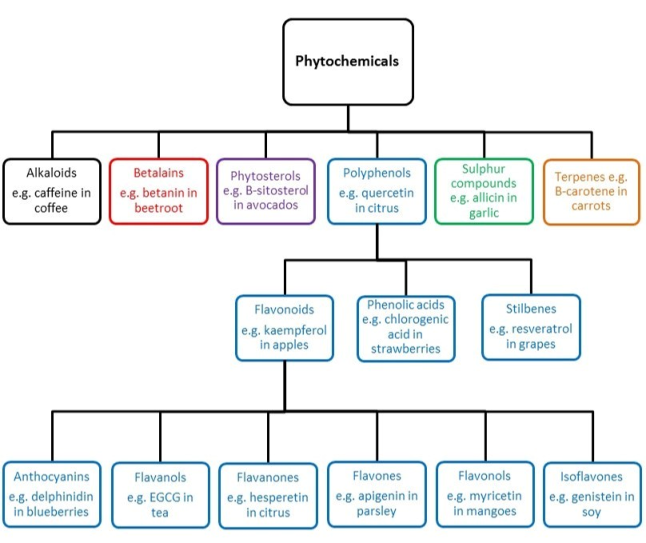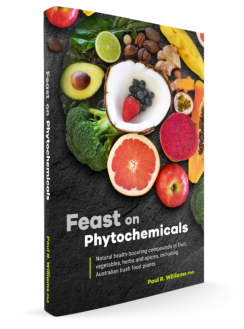Phytochemical groups
Phytochemicals are compounds produced by plants. This site focuses on phytochemicals that are not primary nutrients, that is, not sugars, proteins and fats.
The phytochemical family tree
Phytochemicals are the colourful pigments in fruit, the flavour of spices and the stimulants in coffee and tea. Phytochemicals are typically grouped into the following broad categories, with many vitamins (such as vitamin C) also considered phytochemicals:

Alkaloids
Alkaloids contain nitrogen but have a different structure to the amino acids that make up proteins. Examples of alkaloids are caffeine in coffee and tea, capsaicin in found in chillies, piperine in pepper and theobromine in chocolate. These alkaloids act as stimulants and appear to increase the metabolic rate of some people, potentially helping to burn fat. The alkaloid capsaicin may help reduce the perception of pain.
Betalains
Betalains provide yellow to red colouration to flowers and other plant parts including the red of beetroots, from which they derive their name. They are also found in prickly pear cactus and dragon fruits. Examples are betanin and indicaxanthin. Betalains have a direct antioxidant capacity and also promote our cells to produce the strong antioxidant, glutathione. They can help protect LDL ‘bad’ cholesterol from oxidative damage and inhibit inflammation. Betalains may even contribute to lowering blood pressure by increasing nitric oxide.
Phytosterols
Phytosterols are chemically related to cholesterol and are found in seeds of various plants, especially legumes, nuts and whole grains such as sorghum. They include coumestrol in peas, plus beta-sitosterol and campesterol in avocados and macadamia nuts. As they are similar in structure to cholesterol, phytosterols are thought to help balance cholesterol levels by competing with cholesterol absorption from the gut. Phytosterols can interact with oestrogen receptors and mimic the activity of the hormone oestrogen. Some studies, using mice as subjects, suggest they may contribute to lowering the risk of developing some cancers, by helping promote cell death in tumours.
Polyphenols
Polyphenols are based on the compound phenol, which contains six carbon atoms joined into a ring structure, and include the broad groups flavonoids, phenolic acids and stilbenes. Curcumin in turmeric and gingerol in ginger are also polyphenols. Tannins are large complex polyphenols containing many units joined together, such as ellagitannins in pomegranate and proanthocyanidins in berries. The large group of health-promoting polyphenols called flavonoids include anthocyanins found in blueberries, catechins in tea, quercetin in many fruit such as apples and citrus, and genistein found in soy.
Sulphur Compounds
Sulphur compounds include allicin in garlic, indol-3-carbonol (I3C) in kale and sulforaphane from broccoli and cabbage. Plants make sulphur compounds as toxins to inhibit herbivorous insects, but they provide health benefits to us at the concentrations found in a typical diet. Evidence is building that sulphur phytochemicals can contribute to stimulating detox and to help reduce the risk of developing some cancers.
The sulphur compounds are stored within plants in an inactive state, as part of a larger parent compound, requiring transformation before they become active. When plant tissue is broken, an enzyme stored in a separate compartment of its plant cells mixes with the parent compound, producing the active sulphur phytochemical. This happens after an insect chews leaves or a chef chops ingredients. An example is the pungent smell of cut garlic, which results from the conversion of the parent compound alliin, via the enzyme alliinase, to the active phytochemical allicin. Heat damages the enzymes responsible for converting the compounds into active states. Therefore let sliced garlic and onions sit for several minutes before cooking, to allow the chemical conversion to occur and only stem broccoli and Brussel sprouts for a few minutes.
Terpenes
Terpenes are a broad group of fat and oil soluble phytochemicals. They include carotenoids, xanthophylls, monoterpenes, triterpenes. Carotenoids include alpha- and beta-carotene (from which our bodies can make vitamin A), astaxanthin (the orange colouring of salmon, which originates from the algae they eat), lutein, lycopene (the red colouring of tomatoes) and zeaxanthin. Carotenes play an important role in plants, especially as antioxidants around cells involved with photosynthesis. They also provide numerous health benefits, including as key antioxidants in eye health and potentially in reducing the development of some cancers, such as prostate cancer.
Limonene
Limonene provides the citrus smell of oranges and lemons and is concentrated in their peels. It is a type of terpene called a monoterpene and stimulates the detoxification process. Saponins, found in legumes and quinoa, are another type of terpene.
Find out more…
This site is dedicated to improving our understanding of phytochemicals, especially their capacity to contribute to our long term health… Read more
The phytochemicals in the plants we eat provide important health benefits through their antioxidant and anti-inflammatory properties… Read more
Australia is home to a huge diversity of significant plants and has ancient biological links with Africa, India and South America, and… Read more
How plants are grown affects the concentration of phytochemicals. Cultivation techniques can be refined to enhance the… Read more
Buy the Book
$30.00 + P&H
This book brings the science of plant compounds to people interested in healthy eating and nutrition. It interprets the latest scientific research about health promoting phytochemicals that are supplied to us in common fruit and vegetables (including nuts, legumes and whole grains), herbs and spice.


